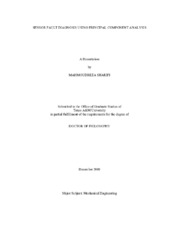| dc.contributor.advisor | Langari, Reza | |
| dc.creator | Sharifi, Mahmoudreza | |
| dc.date.accessioned | 2010-07-15T00:15:53Z | |
| dc.date.accessioned | 2010-07-23T21:46:49Z | |
| dc.date.available | 2010-07-15T00:15:53Z | |
| dc.date.available | 2010-07-23T21:46:49Z | |
| dc.date.created | 2009-12 | |
| dc.date.issued | 2010-07-14 | |
| dc.date.submitted | December 2009 | |
| dc.identifier.uri | https://hdl.handle.net/1969.1/ETD-TAMU-2009-12-7579 | |
| dc.description.abstract | The purpose of this research is to address the problem of fault diagnosis of sensors which measure a set of direct redundant variables. This study proposes:
1. A method for linear senor fault diagnosis
2. An analysis of isolability and detectability of sensor faults
3. A stochastic method for the decision process
4. A nonlinear approach to sensor fault diagnosis.
In this study, first a geometrical approach to sensor fault detection is proposed. The sensor fault is isolated based on the direction of residuals found from a residual generator. This residual generator can be constructed from an input-output model in model based methods or from a Principal Component Analysis (PCA) based model in data driven methods. Using this residual generator and the assumption of white Gaussian noise, the effect of noise on the isolability is studied, and the minimum magnitude of isolable fault in each sensor is found based on the distribution of noise in the measurement system.
Next, for the decision process a probabilistic approach to sensor fault diagnosis is presented. Unlike most existing probabilistic approaches to fault diagnosis, which are based on Bayesian Belief Networks, in this approach the probabilistic model is directly extracted from a parity equation. The relevant parity equation can be found using a model of the system or through PCA analysis of data measured from the system. In addition, a sensor detectability index is introduced that specifies the level of detectability of sensor faults in a set of redundant sensors. This index depends only on the internal relationships of the variables of the system and noise level.
Finally, the proposed linear sensor fault diagnosis approach has been extended to nonlinear method by separating the space of measurements into several local linear regions. This classification has been performed by application of Mixture of Probabilistic PCA (MPPCA).
The proposed linear and nonlinear methods are tested on three different systems. The linear method is applied to sensor fault diagnosis in a smart structure and to the Tennessee Eastman process model, and the nonlinear method is applied to a data set collected from a fully instrumented HVAC system. | en |
| dc.format.mimetype | application/pdf | |
| dc.language.iso | eng | |
| dc.subject | Sensor Fault Diagnosis
Principal Component Analysis | en |
| dc.title | Sensor Fault Diagnosis Using Principal Component Analysis | en |
| dc.type | Book | en |
| dc.type | Thesis | en |
| thesis.degree.department | Mechanical Engineering | en |
| thesis.degree.discipline | Mechanical Engineering | en |
| thesis.degree.grantor | Texas A&M University | en |
| thesis.degree.name | Doctor of Philosophy | en |
| thesis.degree.level | Doctoral | en |
| dc.contributor.committeeMember | Parlos, Alexander | |
| dc.contributor.committeeMember | Bhattacharyya, Shankar | |
| dc.contributor.committeeMember | Gutierrez, Richardo | |
| dc.type.genre | Electronic Dissertation | en |
| dc.type.material | text | en |


